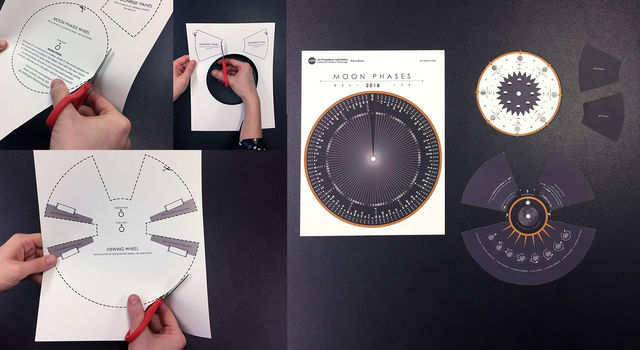DIY Moon Kit from NASA Helps You Track Lunar Phases

Make a New Year's resolution to get out and look at the moon more often, with help from a free, do-it-yourself Moon Phases Calendar and Calculator from NASA.
We love this NASA Moon Phases Calendar because it tells you the date the phases the moon will will occur, as well as what time of day you can see Earth's satellite and in which direction. Following the moon's changing position in the sky from night to night, and month to month, can be a fun, easy and often surprising astronomical activity for both kids and adults.
To make the calendar at home, you'll first need to print the free template from NASA's Jet Propulsion Laboratory (JPL), using a color printer that can do doubled-sided printing. (If you don't have one at home, check with a local print shop.) You'll need a few other supplies as well: a hole punch; a brass fastener; scissors; tape; and a pen, pencil or black marker.

Construction of the calendar requires some knowledge of the moon's phases — but if you aren't familiar with the phase, you can check NASA's website or make a moon journal to observe the phases yourself. The calendar is interactive; users move the interlocking panels to find out what phase the moon will be in on a particular date. Or they can search for the next occurrence of a particular phase (so, for example, the calendar can tell you when the next full moon is).
You can find the template and instructions here. And if you want to know what the 2018 moon phases will be like from the Northern and Southern Hemispheres, check out these awesome videos from NASA's Goddard Space Flight Center below.
2018 Moon Phases (Northern Hemisphere)
2018 Moon Phases (Southern Hemisphere)
Get the Space.com Newsletter
Breaking space news, the latest updates on rocket launches, skywatching events and more!
Follow Calla Cofield @callacofield. Follow us @Spacedotcom, Facebook and Google+. Original article on Space.com.
Join our Space Forums to keep talking space on the latest missions, night sky and more! And if you have a news tip, correction or comment, let us know at: community@space.com.

Calla Cofield joined Space.com's crew in October 2014. She enjoys writing about black holes, exploding stars, ripples in space-time, science in comic books, and all the mysteries of the cosmos. Prior to joining Space.com Calla worked as a freelance writer, with her work appearing in APS News, Symmetry magazine, Scientific American, Nature News, Physics World, and others. From 2010 to 2014 she was a producer for The Physics Central Podcast. Previously, Calla worked at the American Museum of Natural History in New York City (hands down the best office building ever) and SLAC National Accelerator Laboratory in California. Calla studied physics at the University of Massachusetts, Amherst and is originally from Sandy, Utah. In 2018, Calla left Space.com to join NASA's Jet Propulsion Laboratory media team where she oversees astronomy, physics, exoplanets and the Cold Atom Lab mission. She has been underground at three of the largest particle accelerators in the world and would really like to know what the heck dark matter is. Contact Calla via: E-Mail – Twitter









